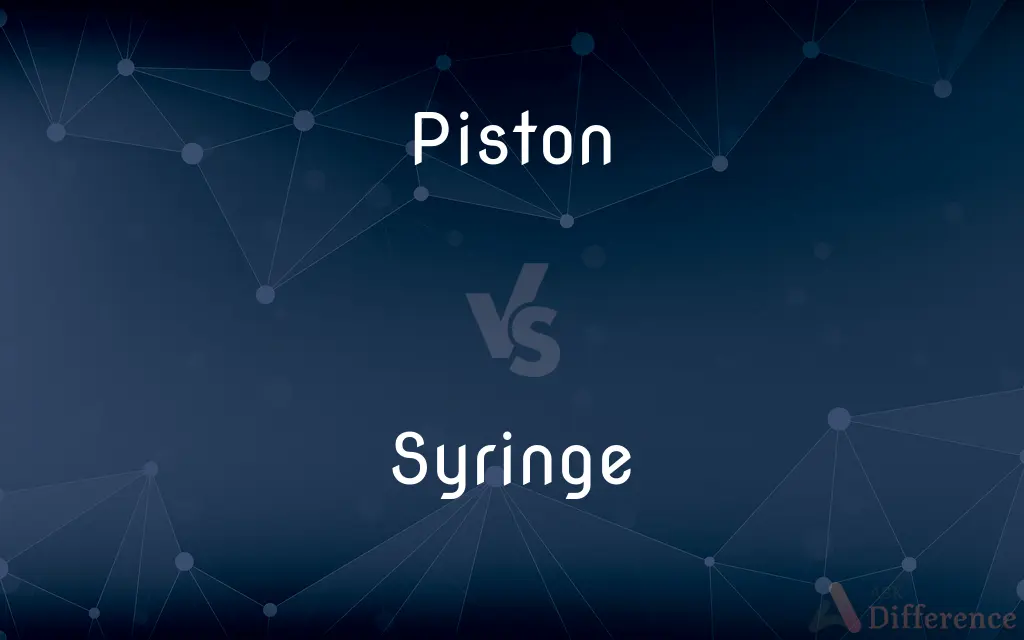Piston vs. Syringe — What's the Difference?
Edited by Tayyaba Rehman — By Urooj Arif — Updated on May 8, 2024
Pistons are mechanical devices used to transfer force in engines, while syringes are medical tools used to inject fluids into or withdraw them from the body.

Difference Between Piston and Syringe
Table of Contents
ADVERTISEMENT
Key Differences
A piston is a component of engines and pumps, functioning by moving within a cylinder to create or transmit force. In contrast, a syringe is a medical instrument designed primarily for injecting fluids into the body or withdrawing them, consisting of a plunger that fits snugly within a cylindrical tube.
Pistons are key in converting the expanding gas energy in engines, such as those in cars and airplanes, into mechanical force that drives motion. Whereas, syringes are utilized in medical settings, aiding in the administration of vaccines, medications, and other treatments by allowing precise control over fluid volume.
The design of pistons involves durable materials like steel or aluminum, which can withstand high pressures and temperatures typical in engines. On the other hand, syringes are generally made from plastic or glass, materials chosen for sterility and clarity, which are crucial in medical applications.
Pistons operate through a repetitive linear motion within a sealed cylinder, driven by the combustion of fuel or other mechanical processes. Meanwhile, syringes operate manually by a user applying pressure to the plunger, enabling the precise delivery or extraction of fluids.
While pistons are integral to the functionality of various mechanical systems, requiring regular maintenance to manage wear and tear, syringes are often disposable, designed for one-time use to ensure hygiene and prevent cross-contamination in medical environments.
ADVERTISEMENT
Comparison Chart
Primary Use
Transferring force in mechanical systems
Injecting or withdrawing fluids medically
Operating Principle
Converts gas or fluid pressure into motion
Manual operation of plunger
Material
Steel, aluminum
Plastic, glass
Motion Type
Reciprocal linear motion
Manual push or pull
Usage
Reusable and part of a larger system
Often disposable, standalone tool
Compare with Definitions
Piston
An integral part of a compressor in refrigeration systems.
The piston in the refrigerator compressor cycles coolant throughout the system.
Syringe
A device used to draw fluids from the body for testing.
Blood samples are often collected using a syringe.
Piston
A device used in pumps to compress or move fluids through a system.
Pistons in hydraulic systems enable heavy machinery to operate smoothly.
Syringe
A part of medical kits for emergency treatments.
Emergency responders carry syringes to provide quick medical interventions.
Piston
A cylindrical engine component that moves within a cylinder to create mechanical force.
The piston transfers energy from the engine's combustion process to drive the car.
Syringe
A medical tool for injecting medications into the body.
The nurse used a syringe to administer the vaccine.
Piston
A moving part of a musical instrument that changes the pitch of the sound.
Trumpets have pistons that alter notes during performances.
Syringe
A tool in culinary arts for injecting flavors into foods.
A syringe filled with marinade enhances the flavor of roasted meats.
Piston
A key element in certain types of guns to load the next round.
In some rifles, the piston enables automatic reloading.
Syringe
A precision instrument in scientific research for measuring liquids.
Researchers use syringes to handle chemicals accurately.
Piston
A piston is a component of reciprocating engines, reciprocating pumps, gas compressors, hydraulic cylinders and pneumatic cylinders, among other similar mechanisms. It is the moving component that is contained by a cylinder and is made gas-tight by piston rings.
Syringe
A syringe is a simple reciprocating pump consisting of a plunger (though in modern syringes, it is actually a piston) that fits tightly within a cylindrical tube called a barrel. The plunger can be linearly pulled and pushed along the inside of the tube, allowing the syringe to take in and expel liquid or gas through a discharge orifice at the front (open) end of the tube.
Piston
A solid cylinder or disk that fits snugly into a larger cylinder and moves under fluid pressure, as in a reciprocating engine, or displaces or compresses fluids, as in pumps and compressors.
Syringe
A medical instrument used to inject fluids into the body or draw them from it.
Piston
(Music) A valve mechanism in brass instruments for altering the pitch.
Syringe
A hypodermic syringe.
Piston
A solid disk or cylinder that fits inside a hollow cylinder, and moves under pressure (as in an engine) or displaces fluid (as in a pump)
Syringe
A device used for injecting or drawing fluids through a membrane.
Piston
(music) A valve device in some brass instruments for changing the pitch
Syringe
A device consisting of a hypodermic needle, a chamber for containing liquids, and a piston for applying pressure (to inject) or reducing pressure (to draw); a hypodermic syringe.
Piston
(intransitive) To move up and down or in and out like a piston.
Syringe
To clean or rinse by means of a syringe.
Have your ears syringed! They're so dirty!
Piston
A sliding piece which either is moved by, or moves against, fluid pressure. It usually consists of a short cylinder fitting within a cylindrical vessel along which it moves, back and forth. It is used in steam engines to receive motion from the steam, and in pumps to transmit motion to a fluid; also for other purposes.
Syringe
To inject by means of a syringe.
Piston
United States neoclassical composer (1894-1976)
Syringe
A kind of small hand-pump for throwing a stream of liquid, or for purposes of aspiration. It consists of a small cylindrical barrel and piston, or a bulb of soft elastic material, with or without valves, and with a nozzle which is sometimes at the end of a flexible tube; - used for injecting animal bodies, cleansing wounds, etc.
Piston
Mechanical device that has a plunging or thrusting motion
Syringe
To inject by means of a syringe; as, to syringe warm water into a vein.
Syringe
To wash and clean by injection from a syringe.
Syringe
A medical instrument used to inject or withdraw fluids
Syringe
Spray or irrigate (a body part) with a syringe
Common Curiosities
Are pistons found in any devices other than engines?
Yes, pistons are also used in pumps, hydraulic systems, musical instruments, and certain types of firearms.
How does a syringe work?
A syringe works by the user manually operating a plunger within a cylindrical tube to inject or withdraw fluids.
Can syringes be reused?
Medical syringes are generally designed for single use to prevent contamination, though some types specifically designed for multiple uses do exist.
What are the maintenance requirements for pistons?
Pistons require regular maintenance to manage wear and tear, especially in mechanical and automotive systems.
What is the difference in material between pistons and syringes?
Pistons are made from metals like steel and aluminum, whereas syringes are usually made from sterilizable materials such as plastic or glass.
Are there non-medical uses for syringes?
Yes, syringes are also used in culinary arts for injecting flavors, in scientific research for precise measurements, and in various industrial applications.
How does the environment affect the design of pistons and syringes?
Pistons are designed to withstand harsh, high-pressure environments, whereas syringes need to be sterile and clear for safe medical use.
What is the primary function of a piston?
The primary function of a piston is to transfer force within an engine or pump, facilitating movement or mechanical operations.
What type of piston is used in refrigeration systems?
Refrigeration systems typically use a compressor piston to cycle coolant and regulate temperature.
What materials are used to make pistons?
Pistons are typically made from metals such as steel or aluminum due to their strength and durability under high-pressure conditions.
How do syringes contribute to safety in healthcare?
By being predominantly disposable, syringes help prevent the spread of infections and cross-contamination among patients.
Can pistons be used in toys?
Yes, some toys, especially model engines and educational kits, incorporate small pistons to demonstrate mechanical principles.
Why are syringes important in medical settings?
Syringes are crucial for administering medications, vaccines, and withdrawing fluids like blood, essential for treatment and diagnosis.
How do the motions of pistons and syringes differ?
Pistons move reciprocally within a cylinder driven by mechanical forces, while syringes are operated manually by pressing or pulling the plunger.
What advancements have been made in syringe technology?
Recent advancements include safety syringes that automatically retract the needle after use to prevent needlestick injuries and contamination.
Share Your Discovery

Previous Comparison
Ideology vs. Idea
Next Comparison
Declaim vs. ProclaimAuthor Spotlight
Written by
Urooj ArifUrooj is a skilled content writer at Ask Difference, known for her exceptional ability to simplify complex topics into engaging and informative content. With a passion for research and a flair for clear, concise writing, she consistently delivers articles that resonate with our diverse audience.
Edited by
Tayyaba RehmanTayyaba Rehman is a distinguished writer, currently serving as a primary contributor to askdifference.com. As a researcher in semantics and etymology, Tayyaba's passion for the complexity of languages and their distinctions has found a perfect home on the platform. Tayyaba delves into the intricacies of language, distinguishing between commonly confused words and phrases, thereby providing clarity for readers worldwide.













































